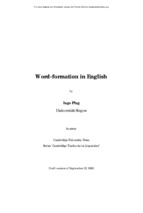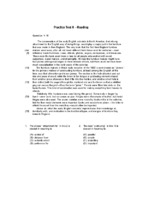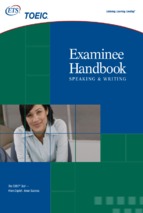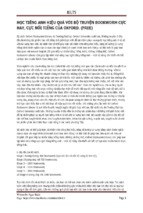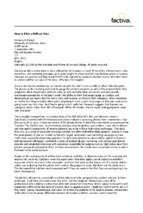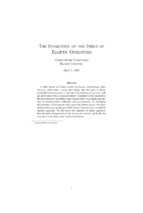Answers
Fundamentals Level – Skills Module, Paper F4 (VNM)
Corporate and Business Law (Vietnam)
1
December 2007 Answers
The question tested the candidates’ knowledge of how the Vietnamese legal system accommodates a situation in which there is
an absence of a law to resolve a legal case.
The Vietnamese legal system is a codified (or civil) law system in which legislation is the dominant source of law. Statutes are
enacted by the government and subordinate bodies in order to provide a body of law with which all individuals and entities must
comply. Courts base their judgements on the literal provisions of legislation and must consider the precise words used.
Inevitably, the promulgation of new laws sometimes fails to keep up with the pace of change in society, which leads to voids in
the law and difficulties in dealing with new or unique situations.
Unlike their counterparts in common law systems, the judges in the Vietnamese courts do not create laws. The role of judges is
to interpret the law and to apply it according to the intentions of the legislator.
Faced with voids in the law, sometimes referred to as law lacunae, there are several possible courses of action that may be taken.
If the issue is sufficiently important and likely to become more so in the future, the government may decide to enact new primary
legislation in order that the problem does not recur. Alternatively, the government may decide to amend existing legislation in order
that it addresses the matter. However, it is a fundamental principle of law that new legislation should not be effected retrospectively,
so while these actions may eliminate future problems, they will not deal with the matter that is of immediate concern.
If the problem concerning the case is caused by a problem of interpretation or application of existing laws, the government or a
body with appropriate authority may issue a decree or circular to provide guidance to the courts. Such clarifications are regularly
issued by ministers and government departments to provide further guidance to legal practitioners and the subjects of law.
The Vietnamese legal system does not recognise judicial precedent as a source of law. However, this does not mean that judges
do not consider prior cases when drafting their opinions and reaching decisions. Courts have to base their reasoning extensively
on general rules and principles underpinning the regulations. They often draw analogies from statutory provisions.
This may involve considering the historic, conceptual base upon which existing laws are drafted and extending those principles to
deal with the current problem scenario. In effect, this is an attempt to interpret the original intention of the legislator. This may be
appropriate when the law is ambiguous, as the court will consider the underlying spirit of the law to overcome the ambiguity.
Alternatively, the court may adopt a teleological approach by considering the social purpose of the legislation and then apply it in
a manner that is consistent with this purpose.
Finally, in the absence of a law to deal with a situation the court may be influenced by custom and tradition, including its perception
of what would be regarded as a fair outcome based on these factors.
2
The question tested the candidates’ knowledge of the consequences of failing to fulfil a civil obligation.
Matters relating to civil obligations are set down in part three of the Civil Code. Article 280 defines a civil obligation as ‘…acts
whereby one or more subjects…must transfer objects, transfer rights, pay money or provide valuable papers, perform other acts or
refrain from performing certain acts in the interests of one or more other subjects’.
(a)
The nature of a failure to perform a civil obligation may be inferred from Articles 281–301 of the Civil Code, which describe
the different types of obligation and specify the principles for performing obligations. Articles 302 and 308 amplify these
consequences. Failure to perform an obligation may take various forms. If the nature of the bargain between two parties is
the transfer of goods, failure to supply those goods is clearly a failure to perform. However, failure may also arise if the goods
are not delivered in time, if the quality does not meet the agreed standard or if the obligation is performed in the wrong place.
Similar principles apply to the provision of services. An obligation can be negative, such as an undertaking not to act in a
specified manner.
Article 303 governs failure to deliver goods (objects). In the event of failure to deliver a distinctive object, the obligee has a
right to demand that the obligor delivers the particular object. If the object no longer exists, the obligor must pay the value of
the object and compensate the obligee for any damage.
If the failure concerns performing a particular act, Article 304 compels the obligor to perform that act. Alternatively, the obligee
may perform the act or assign the responsibility for doing so to a third party. The obligor must then pay reasonable expenses
and compensate for any damage. Conversely, if the obligation is negative and compels the obligor not to perform a specified
act, the obligee has a right to demand that the obligor ceases to perform the act and compensate any damage.
In relation to late performance of an obligation, several possibilities arise. The obligee may choose to accept late performance
with or without compensation. If the subject matter of the obligation is pecuniary, Article 305(2) empowers the obligee to
claim interest for delay at the basic rate announced by the State Bank at the time the payment was due.
In the context of all of the above, payments for damage may be in respect of physical and spiritual damage. Physical damage
relates to the physical losses suffered while spiritual damage concerns harm to life, health, honour, dignity or reputation. The
payment of a monetary sum compensating the damage should reflect any loss calculable in monetary terms, including loss
of property, reasonable expenses to prevent, mitigate or restore damage and the actual loss or reduction in income. Article
307(3) states that a person causing spiritual damage must also make a public apology and retraction.
7
(b)
The obligee will be able to escape any adverse consequences of failing to discharge a civil obligation if the obligor agrees to
release the obligor from the responsibilities under their agreement.
Under Article 302 of the Civil Code, an obligor is absolved from responsibility for failing to perform an obligation due to an
event of force majeure. This is normally regarded as a catastrophic and unforeseen event that affects the obligor in such a
way that it is unreasonable to expect the obligation to be performed. Many civil obligations actually define what events will
or will not be regarded as forces majeure.
The same article states that the obligor shall not bear responsibility for failure to perform the obligation if is it proven that the
failure is the fault of the obligee.
Article 283 of the Civil Code states that a civil obligation cannot be enforced if the subject matter of the obligation is contrary
to law and social morals.
3
The purpose of this question was to test the candidates’ understanding of grounds for dismissal under the Labour Code.
(a)
The grounds on which an employee may be dismissed are laid down in Article 85(1) of the Labour Code. They are also
supported by the general principles of civil obligations as laid down in the Civil Code.
Article 38 empowers the employer to terminate the contract if the employee regularly fails to fulfil the tasks assigned, if he is
disciplined under Article 85 (see below) or is ill and has no prospect of recovery, subject to time limits.
An employee may be dismissed at any time during a period of probation. However, the Labour Code lays down maximum
periods of time for which probation may apply. Article 32 states that a probationary period must not exceed 60 days with
respect to work which requires specialised or highly technical skill, or 30 days with respect to other work. In effect, this
prevents employers from stipulating unduly long periods of probation in order to dilute the rights of employees.
There are three further situations in which the Labour Code envisages that lawful dismissal will apply:
Firstly, if an employee commits an act of theft, embezzlement, disclosure of business or technology secrets, or other conduct
which is seriously detrimental to the assets or well-being of the organisation, these are justified grounds for dismissal
(Article 85). Embezzlement means depriving the employer of assets by a breach of trust.
Secondly, dismissal may occur where an employee who is disciplined by extension of the period for wage increase or transfer
to another position re-commits an offence during the period when the employee is on trial, or re-commits an offence after the
employee is demoted.
Thirdly, dismissal is lawful when an employee takes an aggregate of five days off in one month or an aggregate of 20 days
off in one year without proper reasons or agreement of the employer.
(b)
The Labour Code elaborates on the procedures necessary to dismiss an employee.
The employer must convene a disciplinary hearing to deal with the alleged breach by the employee. Before this can be held,
the employer must deliver a formal notice to the employee. If the employee fails to attend the disciplinary hearing after three
formal notices being served, the employer may hold the meeting without the employee being present.
The disciplinary hearing must be attended by the employer, the employee and a representative of the executive committee of
the organisation’s trade union. If the organisation does not have a trade union, the district level trade union representative
must attend.
Formal minutes (written records) must be taken at the hearing. These are signed by those attending as a true and accurate
record of proceedings.
The onus is on the employer to prove the case for dismissal by confirming the nature of the breach and corresponding
disciplinary measures. Any such measures must be compliant with the provisions of the Labour Code and the employer’s
internal labour rules.
If the employer and the trade union representative agree on the dismissal, the employer may then dismiss the employee and
notify the relevant labour department of the dismissal.
If the employer and the trade union representative do not agree on this dismissal, a report must be made to the labour
department. Under the provisions of the Labour Code, 30 days must elapse following submission of this report before the
employer may dismiss the employee.
Either the employee or the trade union may appeal the dismissal to the Labour Court.
The employer must send a copy of the decision and the minutes of proceedings to the Department of Labour, War Invalids
and Social Affairs within ten days of the date of issue of the decision.
8
4
The question tested the candidates’ knowledge of the law relating to the formation of a limited liability company and the specific
provisions applicable to the name of a new limited liability company.
(a)
The Law on Enterprises governs the formation of all enterprises. The provisions of chapter II of this statute lay down the
generic requirements for all types of enterprise and the specific regulations relating to the different types of business
organisation.
Further provisions are laid down in the Law on Investment.
Before submitting any formal application for registration, the principals of the proposed business have to agree on matters
such as the name of the new company, the proposed registered address, the type and amount of capital to be raised, the
contents of the Charter and a legal representative if required. Only then can they move forward to submit an application for
business registration.
Article 18 requires that a limited liability company submit a request for business registration in a standard form. This form is
provided by the state registration body.
The standard application must be accompanied by the draft Charter of the proposed limited liability company and a list of
members.
Article 18(3) requires that the list of members be supported by various documents, determined by whether the members are
individuals, domestic legal entities or foreign legal entities. Individual members must provide a copy of their identity cards,
passports or other legal identification. Domestic legal entities must provide a copy of the establishment decision and the
business registration certificate or equivalent. The organisation’s legal representative must provide a power of attorney and
identity card, passport or other identification. For foreign legal entities it is necessary to submit a copy of the business
registration certificate, certified by the body at which the registration was made, no later than three months before the date
of submission of the business registration documents.
If the enterprise is one that is compelled to have statutory capital in place, the application must be supported by the document
of an authorised body or organisation certifying the legal capital. Likewise, if the director or general director requires a
practising certificate, this must also be certified as being in place.
Once the registration authority is satisfied that the application is compliant with all legal requirements, a business registration
certificate is issued within 15 days.
(b)
The legal requirements in respect of the name of a new business enterprise are laid down in Articles 31-34 of the Law on
Enterprises.
Article 31 states that the business name must be written in Vietnamese, must be pronounceable and must allude to the type
of enterprise and the proper name of the enterprise. The name can include numbers and signs.
The business registration body can reject the proposed name of the enterprise if it does not comply with Articles 32-24 of the
Law on Enterprises.
It is forbidden to adopt exactly the same name of a business that is already registered. Article 32 goes on to state that names
associated with state bodies, the armed forces, political organisations, socio-political organisations and occupational sociopolitical organisations cannot be used as the whole or part of the name of a new enterprise. Terms that contravene national
historical traditions, culture, ethics and fine customs are also prohibited.
Article 33 permits the organisation to use a translation of the Vietnamese name in a foreign language. The company is entitled
to use the Vietnamese name and the foreign name. However, when used in official documents, the Vietnamese name must
be given greater prominence by being printed or written in a larger size. A company is permitted to use an abbreviation of the
Vietnamese name or foreign name.
Article 34 sets out detailed rules relating to identical names and names that may confuse outsiders.
An identical name is one that is the same in every respect as an existing business name. This applies if the pronunciation of
the two names are the same, even if the characters are different, and where the only difference between two similar names
is the use of ‘&’ and ‘and’. An abbreviated or foreign name that is the same as another company’s abbreviated or foreign name
is considered to be identical.
Where the only difference between the name of the new company and an existing company is a cardinal or ordinal number
after the name, this is deemed to be a name that will cause confusion. Similarly, if the word ‘tan’ preceding the proper name
or the word ‘moi’ immediately following the proper name is the only difference between the registered enterprise and the new
company, this also is regarded as a name that will cause confusion. The same rule applies if the only differentiators are words
such as ‘north’, ‘south’, ‘east’, ‘west’ or ‘central part’.
9
5
This question asked candidates to explain the provisions of the Law on Enterprises in respect of the organisational and management
structure and the criteria and conditions in respect of authorised representatives of limited liability companies.
(a)
The requirements relating to the organisational and management structure of limited liability companies are set out in chapter
III, Articles 46 and 47 of the Law on Enterprises.
Article 46 requires any limited liability company with two or more members to have a Members’ Council, a Chairman of the
Members’ Council and a director or general director.
The chairman of the Members’ Council, the director or general director shall be the legal representative of the company in
accordance with its Charter. The legal representative must permanently reside in Vietnam. Where this person is absent from
Vietnam for more than 30 days, he or she must authorise another person in writing to perform the rights and obligations of
the legal representative of the company.
For limited liability companies with more than 11 members an Inspection Committee is mandatory. This body is optional for
smaller companies, depending on the needs of the company. The powers, obligations, criteria, conditions, and working
regulations of the Inspection Committee shall be stipulated in the Charter of the company.
Article 47 elaborates on legal requirements in respect of the Members’ Council. The Members’ Council is made up of all
members of the company and is the major decision-taking organ of the company. Where a member is a corporate body, that
body may appoint an authorised representative. The Charter governs the frequency of meetings. However, Article 47 specifies
that a minimum of one meeting must be held annually.
The rights and duties of the Members’ Council include, inter alia, making decisions on business plans, strategy and capital,
election, removal, discharge and remuneration of senior personnel, approval of financial statements and profit distributions,
making amendments to the Charter, and reorganisation of the company.
(b)
Article 48 governs the appointment of authorised representatives of limited liability companies and the criteria that they must
fulfil.
Article 48(1) states that the appointment must be in writing and notified to both the company and the business registration
body within seven working days of the appointment. The formal notice must set out:
The name and address of head office, nationality, number and date of the decision or the business registration.
The ratio of capital contribution, number and date of the capital contribution certificate.
Full name, permanent address, nationality, number of people’s identity card, passport or other personal identification of the
authorised representative.
Term of authorisation.
Full name and address of the legal representative of the member and of the authorised representative of the member.
Any change of authorised representative must be similarly notified within seven working days of the change.
Article 48(2) requires that the authorised representative must have full legal capacity and not be prohibited from
establishment or management of enterprises. The authorised representative must have appropriate qualifications and
experience for the lines of business. Close relatives of those in management positions in enterprises where the state owns in
excess of 50% of capital contribution may not serve as authorised representatives.
Article 48(3) states that an authorised representative shall perform the rights and obligations of a member of the Members’
Council in the name of such a member. The member may not place conditions on the authority of the representative.
Article 48(4) obliges the authorised representative to attend all meetings of the Members’ Council and to perform rights and
obligations in an honest and diligent manner and to the best of his ability in the best interests of the member and the
company.
Article 48(5) states that the authorised representative has a number of votes in proportion to the authorised share of capital
contribution.
6
The question sought to test the candidates’ knowledge of the provisions of the Law on Enterprises in respect of ordinary shares
issued to founding shareholders of a new shareholding company.
The provisions relevant to this answer are set out in Article 84 of the Law on Enterprises.
The founding shareholders of a shareholding company must together subscribe for a minimum of 20% of the number of ordinary
shares that may be offered for sale. They must pay for these shares in full within 90 days of the date of issuance of the business
registration certificate to the company by the state registration body.
In that same period, the company must notify the state registration body of the contribution of share capital. This notice must set
out:
Name, address of head office, number and date of business registration certificate and the registered location of the business.
The total number of ordinary shares that may be offered for sale and the number of shares taken up by founding shareholders.
10
Where the shareholder is an individual, the name, permanent address, nationality and number of people’s identity card, passport
or other identification document.
Where the shareholder is a body corporate (separate legal entity), the name, permanent address, nationality and number of
decision on establishment or number of business registration.
In respect of each individual or corporate shareholder, the number of shares to be subscribed, the number of shares already paid
for and types of assets contributed as consideration for the shares.
The total number and value of shares already paid for by founding shareholders.
Full name and signature of the legal representative of the company.
The legal representative is responsible for any damage to the company and to third parties arising from late notification or
untruthful, inaccurate or incomplete notification.
Where a founding shareholder fails to pay for the shares in full, the unpaid shares will be dealt with by all other founding
shareholders taking up the allotment on a pro rata basis, by one or more of the other founding shareholders taking up the allotment,
or a third party taking up the allotment. In all of these cases, the founding shareholder who failed to contribute ceases to be a
shareholder in the company.
While the number of founding shares remain unpaid, the founding shareholders are jointly liable for debts and property obligations
up to the value of the unpaid shares.
Where the founding shareholders do not subscribe in full for all of the founding shares, the unpaid shares must be offered for sale
and allotted within three years of issuance of the business registration certificate.
Within three years from issuance of the business registration certificate, ordinary shares held by founding shareholders may be
assigned to other founding shareholders. They may also be allocated to persons who are not founding shareholders subject to
approval of the general meeting of shareholders. Those intending to assign shares may not vote on this matter as they are interested
parties. If assignment is approved, the assignee becomes a founding shareholder.
Restrictions on transactions in founding shares are lifted after the three year statutory period.
7
The question tested the candidates’ understanding of the term ‘corporate governance’ and required an explanation of ways in which
the Law on Enterprises promotes good standards of corporate governance.
(a)
Corporate governance is concerned with the standards of behaviour of those entrusted with the management and direction of
corporate entities. Good corporate governance requires such persons to act in a manner that is consistent with the objectives
of the stakeholders of the enterprise. The term ‘stakeholder’ refers to any person who can be affected by the actions of the
organisation as well as those who can influence it. Stakeholders are diverse and include shareholders, customers, suppliers,
providers of loan capital, the community and the environment.
Good corporate governance is more than simply complying with the law, but undoubtedly the first step in achieving good
standards of corporate governance is ensuring that the company acts legally and lawfully. This may be taken for granted in
many organisations, but real life experience suggests that even large, well-established companies can be deficient. Worldwide
examples include the recent corporate fraud at Enron in the USA, the insider dealing scandal at Guinness in the UK during
the 1980s and indiscriminate dealings in derivatives at Barings Bank in Singapore in the early 1990s.
Corporate governance implies adherence to a set of standards that should be expected of managers occupying positions of
responsibility in which decisions and actions impact directly and indirectly on others in society.
In recent years the concept of fiduciary responsibility has developed. A fiduciary is a person who has responsibility for the
assets or welfare of others, and who, therefore, owes to others a duty of faithful service.
Corporate law has evolved to ensure that closely connected stakeholders, such as the shareholders and creditors of
companies, are duly protected. It also ensures that directors and general directors of companies are accountable to some
extent for inappropriate actions that bring harm to others, such as the general laws on non-contractual obligations (set out in
the Civil Code) and specific measures governing health and safety at work.
It is generally accepted that company law alone falls short of ensuring good standards of corporate governance. A second
layer of control therefore lies with other external bodies, such as those who decide the listing rules for major capital markets
such as the stock exchange. These are not legally binding rules but they serve a similar purpose, in that a continued listing
is contingent on compliance with the required standards.
(b)
The Law on Enterprises provides a basic level of protection for the shareholders and creditors of companies:
Formation and operation:
The Law on Enterprises sets down minimum standards to which the different types of company must comply with when
applying for registration and while they remain on the state register. Articles 7, 8 and 9 lay down requirements in respect of
lines of business, the rights of enterprises and their obligations respectively. Article 12 requires companies to maintain
mandatory records. Chapters II and III of the Law on Enterprises specify the formalities required for formation of different types
of company, including the prescribed content of constitutional documents.
11
Management accountability:
The management structure of the company is prescribed by law in Article 46 (for limited liability companies) and Article 95
(for shareholding companies). These articles are supported by minimum criteria to which members of the Members’ Council
must adhere in order to serve in this capacity.
The concept of separate legal personality does not mean that directors can abuse the ‘corporate veil’ to escape personal
accountability. The law exposes directors and general directors to personal accountability for actions that harm the company
or its shareholders. The Law on Bankruptcy makes directors and general directors responsible for intentional or spurious
bankruptcy of the company.
The main contribution of company law is the protection provided to shareholders. The shareholders’ meeting is the main
decision-taking organ of the company and as such those who manage and direct the business are accountable to the
shareholders. Detailed provisions are set down in Articles 96 –106 of the Law on Enterprises. A further example of protection
is the voting requirements to sanction a transaction in which directors or general directors have an interest.
Conflicts of interest:
Article 11 of the Law on Enterprises prescribes a list of prohibited practices. In particular, Article 11(5) forbids operating
illegally and deceitful practices. Article 13(2) sets down persons who may not engage in entrepreneurial activity, thereby
minimising the prospect of potential conflicts of interest.
Capital requirements:
The capital maintenance provisions also ensure that while a relatively permissive approach is taken to increasing capital, the
law is much more restrictive on reducing capital. The underlying rationale for capital maintenance is that the equity in a
company serves as a ‘buffer’ against unforeseen losses.
If a shareholder or creditor enters into a bargain with a company, that person is entitled to be made aware of instances in
which the company’s capital may become diluted, thereby endangering the prospect of being repaid.
Creditors are also safeguarded by the Law on Bankruptcy, which ranks their claims ahead of shareholders in the event of
insolvency.
Employees:
Employees are protected from exploitation by many provisions in the Labour Code that safeguard their rights, including the
content and form of labour contracts, protection against unfair dismissal, compensation in the event of redundancy and
working conditions applicable to all workers and specific groups of workers.
The rights of privacy of employees are protected by Article 38 of the Civil Code.
8
The question sought to test the candidates’ understanding of non-contractual obligations in a situation where one person has
caused harm to another.
Non-contractual obligations are governed by Chapter XXI of the Civil Code, ‘Liability for Compensation for Non-Contractual
Damages’. This chapter codifies the laws of tort.
Contractual relations and consequences of breaches of these are set out exhaustively in the Civil Code. However, in addition to
liabilities that may arise from explicit and implicit bargains between different parties, it is also possible to incur liability arising from
damage caused to persons unknown. The most common liability of this kind occurs when an individual fails to take proper care
and the resultant action (or inaction) of that person causes loss, injury or damage to another.
This situation is envisaged by Article 604 of the Civil Code, which states:
‘A person intentionally or unintentionally harming the life, health, honour, dignity, reputation, property, or other legal rights or
interests of an individual, or harming the honour, reputation, or property of a legal entity or other subject, thereby causing damage,
must compensate (for the damage)’.
Article 605 requires that damage be compensated in full and promptly. The parties may agree on compensation, which can be
money, in specie or performance of an act. Compensation may be by instalments or a one-off payment.
Article 605(2) provides that compensation may be reduced if the damage was caused unintentionally, which in the case of Hai’s
actions is probably the case. It may also be reduced if the damage is disproportionately large to the individual’s short and longterm financial situation.
If the amount of compensation is unrealistic, the person who has caused the damage may request that the court or another state
body reduce the sum payable.
Article 609 elaborates on the damage caused to health. This is assessed in relation to medical treatment, functional losses and
impairment of the individual, loss of income and costs. The damage may include some element of mental suffering.
Hai:
In the scenario described, the facts speak for themselves in that Hai was on the roof of the building and was careless. This
carelessness resulted in damage to a third party. The Article 604 definition explicitly states that intent is not a pre-requisite for
damage to be payable. Therefore Hai is potentially liable for his actions.
12
Hai’s employer:
In practice, Hai’s employer would be liable in the first instance for the damage suffered by Linh. Article 618 of the Civil Code states:
‘A legal entity must compensate for any damage caused by any person belonging to the legal entity during the performance of duties
assigned by it.’
This concept is sometimes referred to as vicarious liability. Essentially, the employer bears responsibility for the actions of employees
in the normal course of their duties.
However, the employer would be able to escape such liability if it was established that Hai was acting outside his normal duties
when the accident occurred (for example, if his job did not involve using the tool that caused the harm, or if Hai was acting
recklessly).
Article 618 goes on to state that the employer can demand that the person at fault for the damage reimburse the employer for any
damage paid to the injured party.
Linh:
From the above it is clear that Linh could claim for the medical treatment required as well as a sum representing mental suffering.
In addition, Linh could claim for loss of income. If Linh’s income is irregular, the court applies a figure that is an average for work
of that type.
9
The question sought to test the candidates’ understanding of the principles of voluntary representation in the context of a problem
scenario.
(a)
The Civil Code lays down the personal rights of citizens and legal entities in Vietnam. Article 14 defines ‘capacity’ as the
‘capability of the individual to have civil rights and civil obligations’. Article 18 states that any person of 18 years of age or
more is an adult. Therefore, in the scenario, one of the grandchildren is an adult and the other is a minor.
Article 20(2) states that persons between 15 and 18 years of age have limited capacity. If they have sufficient property to
secure the performance of obligations they may establish and perform civil transactions without the consent of a legal
representative, provided the law does not expressly forbid the type of transaction proposed.
Lan’s desire to transfer property and permit her grandchildren to carry out transactions on her behalf is supported by these
provisions. Article 109(1) states that members of a family household may appropriate and use household property in
accordance with agreed methods.
As the house is immovable property that must be registered, any proposed transfer would be subject to state registration. Most
movable belongings can be transferred without this formality.
(b)
If Lan wishes to authorise her grandchildren to act on her behalf she should execute a power of attorney.
A power of attorney is a formal legal document that entitles one person (the attorney) to act on behalf of another (the
beneficiary, or donor). The nature of a power of attorney is one of agency in that the representative acts on behalf of the owner,
subject to any limits explicitly contained in the power of attorney document. The power of attorney may be general in nature
or may alternatively restrict the grandchildren to specific types of actions.
Article 142 states that the attorney becomes the authorised representative of the beneficiary. The fact that one of the
grandchildren has not reached adult age is of some relevance, in that the minor may not have unfettered rights to make every
type of transaction. However, Article 143(2) empowers a person aged 15 years or more to act as an attorney provided any
proposed civil transaction is not restricted to those of adult age.
The extent to which Lan is prepared to enter into this arrangement would ultimately depend on the level of trust she could
place in the grandchildren and whether she would be prepared to sacrifice some degree of control over her affairs. She could,
however, vary or terminate the power of attorney if it was later found that the arrangement was unsatisfactory.
10 The question tested the candidates’ ability to apply the provisions of the Law on Bankruptcy to a problem scenario.
(a)
The Law on Bankruptcy lays down the processes that must be followed when a company is declared bankrupt. The procedure
starts with the filing of a petition and commencement of proceedings and, provided there is no prospect of recovery of the
business, ends with a declaration that the enterprise is bankrupt.
The basic procedure is described in Article 5 of the Law on Bankruptcy.
Article 13 gives a right to any creditor to petition the court for the bankruptcy of an enterprise. The petition must include the
date, name and address of petitioner, name and address of the enterprise claimed to be insolvent, details of due debts and
the grounds for the petition being issued. The grounds will usually be the failure of the company to pay the debt as it has
fallen due.
Article 14 also empowers employees of the enterprise to file for bankruptcy. This right is triggered when the enterprise fails
to pay wages as they fall due. The petition may be served by an elected representative or trade union representative. The
representative’s appointment must be supported by at least 50% of the employees of the enterprise. The content of the
petition is similar to that required by others who are owed money, but must include the number of months for which wages
have not been paid and the total amount due.
13
Lastly, the company itself can file for its own bankruptcy. This is an obligation if the company itself observes that it has
become insolvent.
(b)
The total assets of the company are estimated to be 500 million dong.
A fundamental principle underlying the Law on Bankruptcy is that once the liquidation costs have been discharged, secured
creditors rank ahead of unsecured creditors, but sums due to employees rank ahead of both types of obligation (Article 37 of
the Law on Bankruptcy). Therefore, the 75 million dong due in unpaid wages will rank as a priority and the employees will
be paid, assuming the liquidator can realise the estimated value of the company’s assets.
Next, the 300 million dong will be paid to the secured mortgagee as this ranks ahead of any unsecured debts. The unsecured
overdraft will rank behind these claims but ahead of any sums payable to shareholders. This would leave 125 million dong
for distribution to unsecured creditors, who according to the scenario are owed a total of 200 million dong. These claims
would be met on a pro rata basis.
However, it appears that the general director chose to satisfy a debt of 600 million dong prior to the insolvency petition. The
implication in the scenario is that this was to escape the obligation under his personal guarantee. Under Article 43 of the
Law on Bankruptcy this would be treated as a ‘transaction which shall be deemed invalid’. Any transaction within three
months of the petition may fall into this category, including (Article 43(1)(b)) ‘settlement of a bilateral contract in which the
obligation of the enterprise…is clearly greater than that of the other party’. If the liquidator was able to reclaim the 600 dong
arising from this unfair preference, there would be more funds available for distribution to the other unsecured creditors, with
the counterparty to the personal guarantee receiving correspondingly less.
14
Fundamentals Level – Skills Module, Paper F4 (VNM)
Corporate and Business Law (Vietnam)
December 2007 Marking Scheme
1
Passing new law
Amending existing law
Decree, edict, guidance
Principles applied by the courts
Up to 2 marks
1 mark
Up to 2 marks
Up to 5 marks
(Total 10 marks)
2
(a)
Specific performance
Damages and the nature of damages
Up to 2 marks
Up to 5 marks
(Total 7 marks)
(b)
Agreement
Force majeure
Contrary to law, social morals
1 mark
1 mark
1 mark
(Total 3 marks)
(Total 10 marks)
(a)
Probation
Grounds for dismissal
Dishonesty
Re-committing offence
Unauthorised absence
1 mark
1 mark
1 mark
1 mark
1 mark
(Total 5 marks)
(b)
Hearing
Processes
Consequence of hearing
1 mark
Up to 3 marks
1 mark
(Total 5 marks)
(Total 10 marks)
(a)
General procedures
Practical issues
Legal requirements
1 mark
1 mark
4 marks
(Total 6 marks)
(b)
Restriction on existing name
Regulations on similar and confusing names
1 mark
Up to 3 marks
(Total 4 marks)
(Total 10 marks)
(a)
Detailed rules on Members’ Council
Director/general director
Inspectors
Up to 3 marks
1 mark
1 mark
(Total 5 marks)
(b)
Basic details required of representative
Duties and obligations of representative
1 mark
Up to 4 marks
(Total 5 marks)
(Total 10 marks)
6
Basic rules and limits imposed by Law on Enterprises
Disclosure requirements to registration body
Duties to pay for founding shares
Consequences of failure to pay for shares
Reallocation of founding shares
Up to
Up to
Up to
Up to
Up to
(Total
3
4
5
15
2 marks
2 marks
2 marks
2 marks
2 marks
10 marks)
7
(a)
Meaning of corporate governance
Up to 4 marks
(Total 4 marks)
(b)
Formation and operation
Management accountability
Conflicts of interest
Capital requirements
Employees
1 mark
1 mark
1 mark
Up to 2 marks
1 mark
(Total 6 marks)
(Total 10 marks)
8
Nature of non-contractual obligation
Provisions of Civil Code
Consequences
Consequences to Hai
Consequences to employer
Rights of injured party
Up to 2 marks
Up to 2 marks
1 mark
Up to 2 marks
Up to 2 marks
1 mark
(Total 10 marks)
9
(a)
Personal property rights under Civil Code
Personal capacity
State registration of immovable property
Up to 2 marks
Up to 2 marks
1 mark
(Total 5 marks)
(b)
Nature of voluntary representation and power of attorney
Application to scenario
Up to 3 marks
Up to 2 marks
(Total 5 marks)
(Total 10 marks)
Right of creditors to petition
Right of employees to petition
Right of insolvent company to petition
Up to 2 marks
Up to 2 marks
1 mark
(Total 5 marks)
Provisions of Law on Bankruptcy – ranking of claims
Application to scenario
Identification of unfair preference and consequences
Up to 2 marks
Up to 2 marks
1 mark
(Total 5 marks)
(Total 10 marks)
10 (a)
(b)
16
- Xem thêm -


